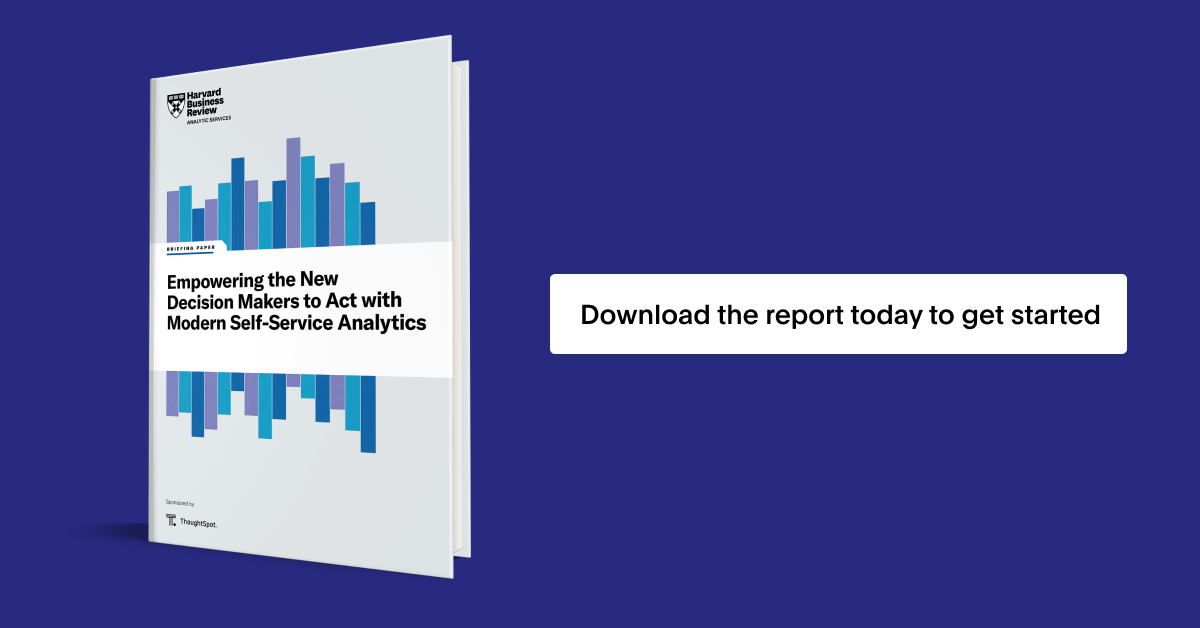Being data-driven is no longer optional. With increased digital dexterity among customers and fast-changing market conditions and disruptions, organizations have entered the defining decade of data. This new era is characterized in part by the need to put live data directly into the hands of frontline decision-makers with self-service analytics.
In a new report from Harvard Business Review, industry leaders at TDWI, NewVantage Partners, and Medtronic shared their perspectives on the shift away from traditional business intelligence tools and why businesses must start investing in self-service today. Here are their top three insights.

1. Modern self-service analytics boost speed, efficiency, accuracy, and trust in business insights.
It’s no surprise that when frontline workers are able to ask and answer their own questions with data rather than wait for data teams to respond, organizations see immediate speed and efficiency gains. But what’s equally exciting, according to NewVantage Partners, is that this process quickly turns into multiple interactions with business data. The more insights they uncover, the more questions they think of. And the more questions they think of, the more they’re able to apply their own domain expertise to every insight, thereby increasing trust in analytics results.
For leaders looking to increase overall adoption of BI tools, this trust is critical. In fact, in a recent survey of business leaders by TDWI, 66% cited trust in data as the most important step to achieving success with BI and analytics. The second highest response? Empowering more users with self-service functionality.
2. Search is a key capability that separates self-service analytics from the rest of the pack
According to TDWI, modern self-service analytics are easy-to-use solutions for non-technical users that require neither coding nor IT to set up the data access, queries, visualization, or preparation necessary to create data-driven insights. Unlike traditional BI tools, they allow users to word questions in natural language and drill down into massive amounts of data as easily as they would use any other consumer app or search engine.
This is a key differentiator given that most frontline workers don’t have the bandwidth to click, drag, drag, and drop hundreds (sometimes thousands) of rows of data into a traditional BI tool to manually build a report. Instead, self-service reporting tools put data at their fingertips and allow them to create insights at the speed of thought, reducing the time it takes to make a data-driven decision and increasing the likelihood that they’ll use the tool again.
3. Empowering frontline workers to take action on insights is just as important as providing them with insights in the first place.
While many organizations pay lip service to the idea of becoming more data-driven, the truth is this transformation requires massive cultural change. Leaders can’t stop at empowering frontline workers to create insights with self-service tools, they must also encourage workers to use and act on insights.
One important action any business can take to foster this cultural change is to improve data literacy both at the organizational and individual business user level. At Medtronic, enhancing data literacy starts with training business users to understand what they're ultimately trying to achieve with the information they’re looking for. The company uses the OAI or “outcomes, actions, and insights” methodology, which encourages workers to think of the outcome first, then back into the actions they would take to achieve that outcome, and the insights needed to drive those actions.
The future is clear
Ultimately, organizations that follow the path to self-service and other advanced analytics capabilities will reap the rewards of empowering every employee to make faster, more accurate, data-driven decisions. To learn more about this new imperative and read additional commentary from the above experts, download the full report today.









